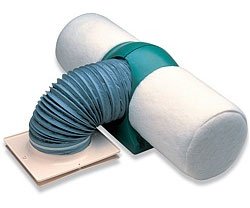Positive Pressure Loft Ventilation System
There are several reasons why it’s important to properly ventilate your home’s loft area. If this area is not ventilated, it can get extremely hot during the summer. This significant increase in temperature will spread to other areas of your home and increase your energy usage. If this hot air doesn’t have anywhere to go, it can warp structural elements in your loft and even shorten the lifespan of your home’s roof.
A lack of ventilation can also trap moisture. If this occurs, it’s likely to lead to mold growth. Mold can cause quite a bit of damage, as well as create breathing complications for anyone living in your home. The importance of proper loft ventilation isn’t only applicable during the summer. In the winter, a loft needs to be ventilated to prevent ice dams from forming. While all of these problems can be serious, you can avoid them by adding a ventilation system to your loft.
What is Positive Pressure Ventilation?
A positive pressure loft ventilation system takes advantage of the basic principle that when hot air rises, it pulls cooler air behind it. In order to create this type of system in your loft, you need to add inlets and outlets. The purpose of the inlets is to let fresh air into the space. Then as air heats up and rises, the outlets give it somewhere to escape. Prior to having this type of system, because air has nowhere to go, it just continues to get hotter. That’s why it can cause all kinds of structural damage.
How Can You Create a Positive Pressure Ventilation System?
There are three components that should be used to create a positive pressure ventilation system:
- Soffit vents
- Ridge vents
- Baffles
It’s possible to use soffit vents as inlets or outlets. One useful feature of this type of vent is it’s designed to keep rain and snow from blowing into your loft. Ridge vents are the other component of a ventilation system that will pull air through the space of a loft. While positive pressure allows air to be pulled along, only adding ridge vents can offset the necessary balance and place too much emphasis on the air that’s being brought into the loft. This is why you also need baffles. They allow you to create the balance that’s necessary for an efficient positive pressure ventilation system.
Is There a Standard Size for a Positive Pressure Loft Ventilation System?
There’s not a single standard size for this type of system. The reason is the right size for one loft may not be a good fit for a loft of a different size. As a result, instead of there being just one size that you should use for your pressure loft ventilation system, there is a rule of thumb for determining the optimal size. This rule of thumb is that for every 300 square feet of loft space, you should add 1 square foot to the total size of your positive pressure ventilation system.

Categories
- Home
- Types Of Loft Ventilation
- Attic Ventilation
- Heat Recovery Ventilation
- Industrial Loft Ventilation
- Loft Roof Space Ventilation
- Natural Ventilation
- Pigeon Loft Ventilation
- Positive Pressure Loft Ventilation System
- Proper Roof Ventilation
- Roof Ventilation
- Soffit Loft Ventilation
- Solar Ventilation
- Loft Ventilation Companies
- Loft Ventilation Information
- Loft Ventilation Products
